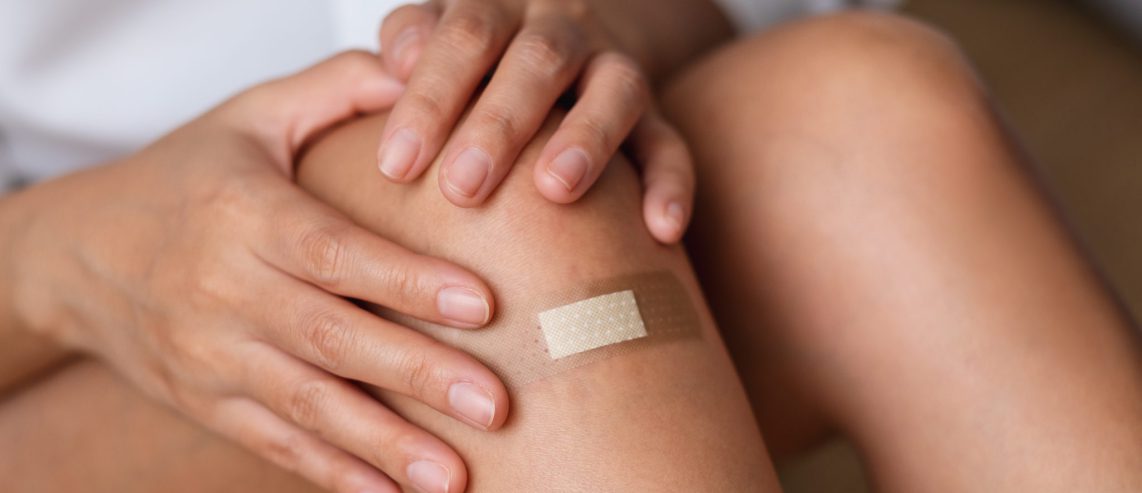You’re washing dishes when a glass breaks and slices your hand. Or you catch your finger in the clippers when you’re trimming the rose bushes.
Even small cuts can bleed a lot if you nick a blood vessel. While the sight of blood can be alarming, you can safely treat most minor cuts at home.
Here’s what you need to know about how to treat a cut, and what first aid items you should have on hand.
The Basics: How to Treat Minor Cuts
The good news is that most small cuts and scrapes heal just fine with home care. The smaller the cut, the more quickly it will heal. With proper care, most minor cuts heal in about a week.
Here are the steps to take to keep your cut clean and speed healing.
Wash your hands
Washing thoroughly with soap and water will reduce risk of infection.
Stop the bleeding
If the cut is still bleeding, apply gentle pressure with a piece of gauze or a clean washcloth. Maintain pressure for a minute or two, or until the bleeding stops.
Wash the cut
Use cool or lukewarm water and a mild soap to wash the injured area. You can also use a mild saline solution if you have some on hand.
When you’re washing the cut, take care to look for any remaining dirt or debris in the wound. You’ll want to rinse out any foreign objects. Pat the cut dry with a clean towel.
Apply a protective barrier
A thin layer of petroleum jelly over the cut will help keep it from drying out. Wounds heal more quickly when they’re moist. You may also use a dab of antibacterial ointment such as Neosporin instead of petroleum jelly.
Cover the cut
Use a sterile bandage to protect the cut from germs. Keeping it covered will help stop it from opening up again. It will also help keep the wound moist.
While your cut is healing, you should change the bandage once a day. (If it gets wet or dirty, you should change it more often.)
Double-check the date of your last tetanus shot
The bacteria that cause tetanus can enter your bloodstream through even a tiny cut. Adults should have a tetanus booster every 10 years. So it’s a good idea to make sure your vaccination status is up-to-date.
Never Miss a Beat!
Subscribe to Our HealthBeat Newsletter!
Thank you for subscribing!
You can now select the specific newsletters you'd like to receive.
You are already subscribed.
Subscribe to more newsletters in our email preference center.
Sorry, an error occurred. Please try again later.
Get Healthy Tips Sent to Your Phone!
First Aid for Cuts
Every household should have at least one first aid kit to treat cuts, scrapes, and other minor injuries. You should also keep a first aid kit in your car and at work.
You can buy ready-to-go first aid kits at most drug stores, or you can assemble your own.
The American Red Cross recommends the following items for a fully-stocked first aid kit. (The amounts shown are for a family of four. You may need more or less, depending on how many people are in your family.)
- Two absorbent compress dressings (5 x 9 inches).
- About 25 adhesive bandages (assorted sizes).
- One adhesive cloth tape (10 yards x 1 inch).
- Five antibiotic ointment packets.
- Five antiseptic wipe packets.
- Two packets of aspirin.
- One emergency blanket.
- One breathing barrier (with a one-way valve) for administering CPR.
- One instant cold compress.
- Two pairs of non-latex gloves.
- Two hydrocortisone ointment packets.
- One 3-inch roller bandage.
- One 4-inch roller bandage.
- Five 3 x 3-inch sterile gauze pads.
- Five 4 x 4-inch sterile gauze pads.
- Oral thermometer (that doesn’t contain mercury or glass).
- Two triangular bandages.
- Tweezers.
- Emergency first aid instructions.
Replace any supplies you use and check the kit regularly for expiration dates. You may include any medications you take regularly, as well as emergency phone numbers.
What Happens If You Don’t Treat a Cut
It’s easy to ignore minor cuts, especially if they don’t hurt too much. But it’s unwise to do so. Germs on your skin can enter your bloodstream through the cut and cause an infection.
An infected wound can cause discomfort and take longer to heal. It can even lead to serious complications like gangrene, bone infections, or sepsis.
Signs of infection after a cut include:
- Redness near the cut.
- Red streaks spreading outward from the cut.
- Swelling, pain, or increased tenderness around the cut.
- Fever.
- Yellow, white, or green liquid oozing from the cut.
If you notice any of these signs of infection, you should call your doctor. They may prescribe antibiotics to treat the infection.
When to Call the Doctor About a Cut
Not all cuts are minor wounds. There are some cuts you shouldn’t attempt to deal with yourself.
You should call 911 for cuts that:
- Are bleeding heavily (i.e., soaking through bandages quickly).
- Are spurting blood, which indicates an artery may have gotten severed.
- Occurred with a severe head or neck injury.
- Resulted in a body part (like a fingertip) getting cut off.
Call your doctor or go to an urgent care center when:
- Bleeding doesn’t stop after 15 to 20 minutes of applying pressure.
- There is dirt, debris, or a foreign object stuck in the wound.
- The cut was from a dirty or rusty object.
- The cut was close to your face, ear, or neck.
- The cut was from an animal or human bite.
- The cut is more than half an inch long.
- The cut appears to be deep.
- The cut is gaping open.
You may need stitches or medical glue for a larger or deeper cut. Don’t hesitate to call your doctor if you’re not sure. It’s important to have stitches within 24 hours of the injury for the wound to heal properly.
Sources
American Academy of Dermatology, How to Treat Minor Cuts, Link
Kidshealth.org, What to Do About Cuts, Link
National Library of Medicine, How Wounds Heal, Link
American Family Physician, Caring for Cuts, Scrapes, and Wounds, Link
CDC, Emergency Wound Care After a Natural Disaster, Link
American Red Cross, A well-stocked first aid kit is a handy thing to have, Link
Kidshealth.org, Cuts, Scratches, and Scrapes, Link
About UPMC
Headquartered in Pittsburgh, UPMC is a world-renowned health care provider and insurer. We operate 40 hospitals and 800 doctors’ offices and outpatient centers, with locations throughout Pennsylvania, Maryland, New York, West Virginia, and internationally. We employ 4,900 physicians, and we are leaders in clinical care, groundbreaking research, and treatment breakthroughs. U.S. News & World Report consistently ranks UPMC Presbyterian Shadyside as one of the nation’s best hospitals in many specialties and ranks UPMC Children’s Hospital of Pittsburgh on its Honor Roll of America’s Best Children’s Hospitals. We are dedicated to providing Life Changing Medicine to our communities.

